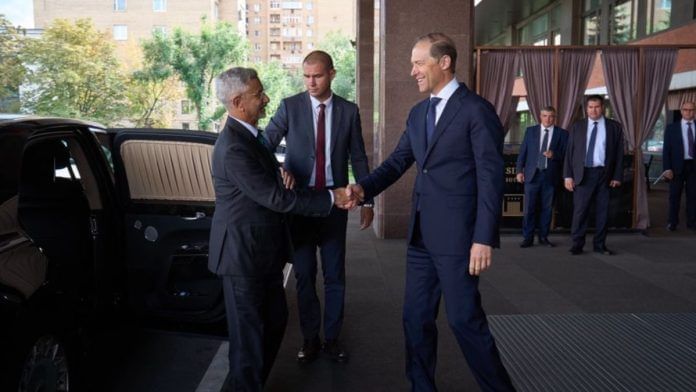New Delhi: India and Russia Wednesday finalised the terms of reference for a free trade agreement between New Delhi and the Eurasian Economic Union (EAEU) as both countries seek to grow trade to $100 billion by 2030. The positive momentum in the India-EAEU FTA comes even as New Delhi’s negotiations for a bilateral trade deal with the US continue to flounder.
“Today, as we meet, allow me to lay out some of the salient features of the agenda before us. Addressing tariff and non-tariff trade barriers, removing bottlenecks in logistics, promoting connectivity through the International North-South Transport Corridor, the Northern Sea Route and the Chennai-Vladivostok Corridor,” India’s External Affairs Minister S. Jaishankar said in his opening remarks as he co-chaired the 26th round of India-Russia Inter-Governmental Commission for Trade, Economic, Scientific, Technological and Cultural Cooperation (IRIGC-TEC) in Moscow Wednesday.
“Effecting payment mechanisms smoothly, timely finalisation and execution of the Programme of Economic Cooperation till 2030, the early conclusion of the India-Eurasian Economic Union FTA, whose terms of reference were finalised today, and regular interaction between the businesses of the two countries—these are among the key elements,” he added.
The Russian-led EAEU was established in 2015, and comprises Armenia, Belarus, Kazakhstan and Kyrgyzstan, apart from Moscow. The countries established a single market in 2012, which was expanded to include Bishkek and Yerevan from 1 January, 2015.
New Delhi’s decision to move forward with negotiations with the Russian-led single market comes as its ties with the US have hit a rough patch. US President Donald Trump has criticised India’s continued purchase of Russian oil, and imposed an additional tariff of 25 percent as penalty on New Delhi, which is set to come into force at the end of this month. The additional tariff will see India’s total levies to touch 50 percent, amongst the highest for trade partners of the US.
India’s primary economic partner in the EAEU is Russia. Last year, trade between the two countries in goods crossed $60 billion, primarily due to New Delhi’s purchases of Russian oil that crossed $56 billion. Russia has grown to become the fourth largest trading partner with India in the last three years, following the start of its war with Ukraine.
Also Read: US treasury secy slams Indo-Russia oil trade, says profits benefits India’s ‘richest families’
Trade imbalance with Russia
The G7 member-states, at the end of 2022, had introduced a price cap on Russian oil, ensuring its sale below $60 a barrel to impact its revenues for the duration of the war. However, former American envoy to India Eric Garcetti had acknowledged the price cap was introduced keeping India in mind.
Russia soon replaced India’s traditional oil suppliers from West Asia as its top choice for the import of crude. In the last financial year (2024-2025), India also exported $16 billion worth of refined petroleum products to the world, with the Netherlands accounting for $13 billion worth of exports alone.
The Trump administration has criticised this aspect, asserting that India has been profiteering from the Russia-Ukraine war. New Delhi rejected these claims earlier this month, pointing out that both the US and the European Union continue to trade with Moscow, despite the almost four-year long war.
Jaishankar is in Russia from 19 August to 21 August. Apart from co-chairing the IRIGC-TEC, the minister is set to hold bilateral talks with his counterpart Sergey Lavrov Thursday.
Russian President Vladimir Putin has spoken with Prime Minister Narendra Modi twice in the last week, updating him of the situation on the frontlines and the outcomes of the summit in Alaska with Trump, which was held on 15 August.
Putin is expected to visit India later this year for the annual bilateral summit. India has had issues with the imbalance in trade ties with the country. India’s merchandise exports to Russia stood at $4.88 billion at the end of 2024-2025. However, its merchandise imports from Moscow were $63 billion during the same period—a $59 billion deficit.
On Wednesday, Russian Charge d’Affaires Roman Babushkin welcomed Indian exports, given the current tariffs New Delhi’s exporters are facing with the US, at a press briefing in New Delhi. Washington DC is India’s largest export market, with merchandise exports touching $86 billion in the last financial year.
“They [the agenda] will not only help to address the imbalance and grow our trade, but also hasten the timely achievement of our revised trade target of USD 100 billion by 2030,” said Jaishankar Wednesday.
In recent weeks, India has engaged diplomatically with both Russia and China. Chinese Foreign Minister Wang Yi was in New Delhi from 18 August to 20 August, as New Delhi and Beijing focus on a thaw in diplomatic ties. Russia welcomed the visit and supports the normalisation of India-China ties, Babushkin said Wednesday.
Moscow and Beijing have also been pushing for resumption of the Russia-India-China (RIC) trilateral format of talks, which have been suspended since the COVID-19 pandemic. New Delhi has distanced itself from agreeing to any date for the RIC format. Russia and China have become closer since Moscow’s war with Ukraine began in February 2022.
(Edited by Mannat Chugh)
Also Read: Russia hopes to revive RIC, criticises US threat of sanctions against India






